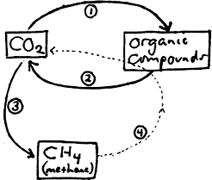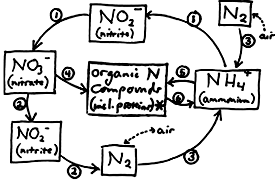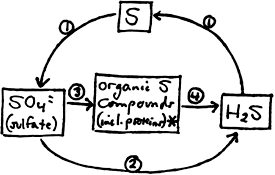|
The Carbon Cycle: Organic compounds are used as carbon source by HETEROTROPHS (by definition). As is also the case for the Nitrogen and Sulfur Cycles below, organic compounds are converted from one to another within plants, animals and microorganisms – also animals eating plants, microorganisms decomposing plants and animals, microorganisms undergoing fermentation, etc.
- Use of CO2 as carbon source of AUTOTROPHS (by definition).
- Release of CO2 as an end product in respiration (and some fermentation) by CHEMOORGANOTROPHS.
- Methanogenesis. (We broadly categorize this unique process as a kind of anaerobic respiration.)
- Methane oxidation (another unique process).
The Oxygen Cycle: (reduced to its absolute essentials)
- Respiration by CHEMOORGANOTROPHS and CHEMOLITHOTROPHS.
- O2 production by oxygenic PHOTOTROPHS.
The Nitrogen Cycle: (A similar view is shown here where there are links to more.)
- Respiration of ammonium and nitrite by CHEMOLITHOTROPHS. This process is called nitrification.
- Dissimilatory nitrate reduction – a form of anaerobic respiration. This process is called denitrification when nitrate is reduced all the way to N2.
- Nitrogen-fixation by certain bacteria under aerobic (upper) and anaerobic (lower) conditions
.
- Assimilatory nitrate reduction performed by plants and microorganisms.
- Assimilatory ammonium uptake performed by plants and microorganisms.
- Ammonification performed by microorganisms.
The Sulfur Cycle:
- Oxidation of sulfide and sulfur by CHEMOLITHOTROPHS (by respiration) and PHOTOLITHOTROPHS.
- Dissimilatory sulfate reduction – a form of anaerobic respiration.
- Assimilatory sulfate reduction performed by plants and microorganisms.
- Desulfurylation performed by animals and microorganisms.
|



